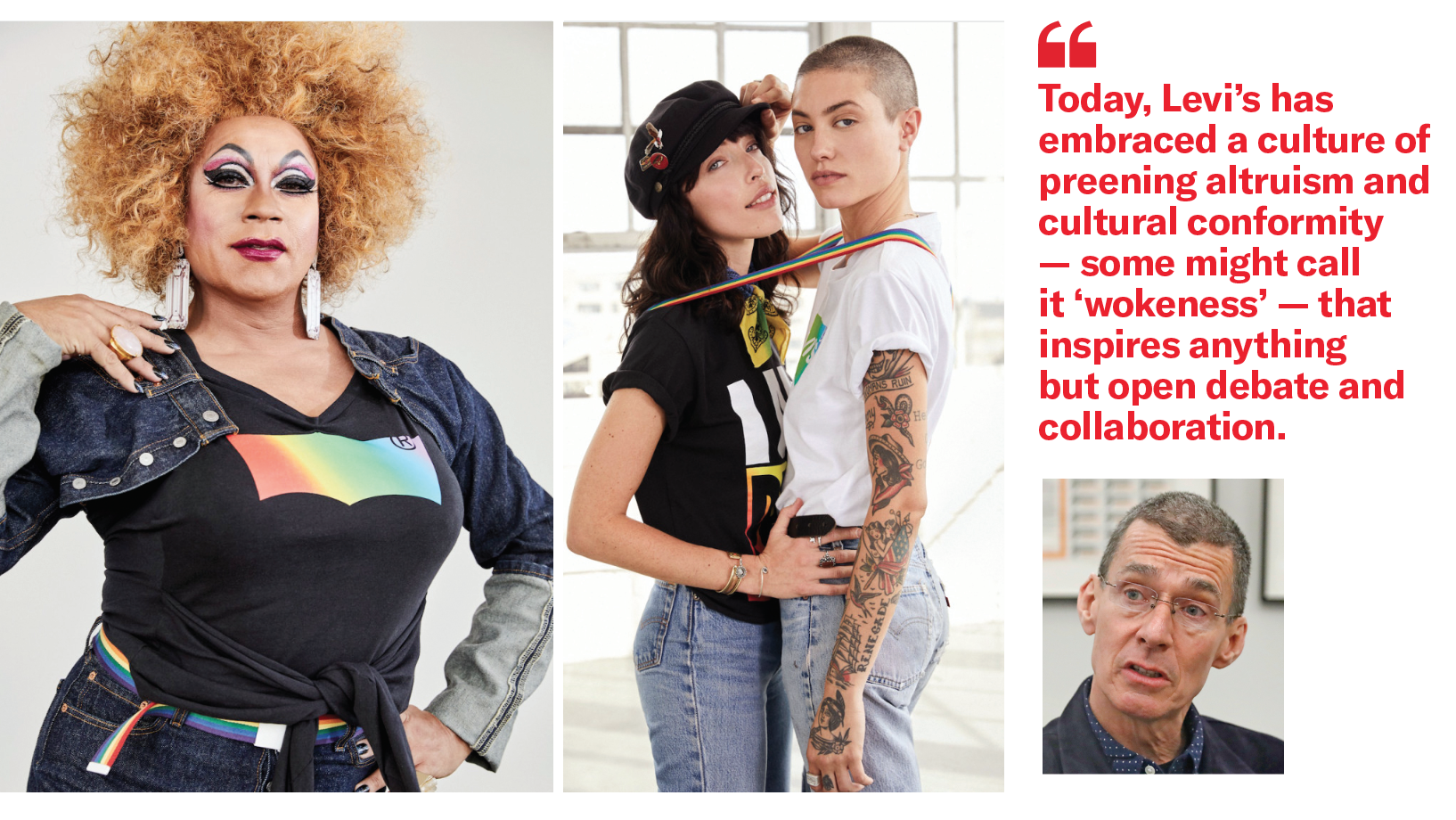This month marks the 150th anniversary of the Levi’s 501 jean. Or as we successfully branded May 20 with marketing efforts directed at establishing the company’s originator status: “The birth of the blue jean.”
I know the importance of branding at Levi’s: My 23 years at the company included eight as chief marketing officer and two as brand president, which ended in 2022 because of my advocacy of reopening public schools, a stance the company couldn’t stomach. Levi’s wrote the first draft of history, as the saying goes, and that draft shows May 20 as the day that the entire class of products known as “jeans” came to be.
BIDEN CAMPAIGN TO SPOTLIGHT GREEN POLICIES IN APPEAL TO YOUNGER VOTERS
But I also know the importance of innovation. Because a company doesn’t make it to the 150th anniversary of its game-changing invention without inventing that product in the first place. Unfortunately, the embrace of polarizing political fads and “woke” ideology, an embrace of which I was the company’s high-profile casualty, threatens and undermines the creative atmosphere and business priorities that make such innovation possible. Levi’s is dismantling the forces that got it here. And it is far from alone.
That Levi Strauss and Company is synonymous with the most iconic and bestselling garment of all time, the 501, is a fact. The origin story told the world over is one of American innovation and problem-solving ingenuity. And it is told nowhere more fervently and proudly than in the hallowed halls of Levi Strauss and Company, one of the oldest San Francisco institutions.

The company was started by an enterprising Bavarian-born dry goods merchant during the gold rush in California in 1853. Levi Strauss ventured to San Francisco to pursue his fortune, where he opened a branch of his brother’s New York dry goods store. It’s a classic “rags to riches” American story, one of free enterprise, progress, and the rugged individualism of “go west, young man,” values the Levi’s brand has worked hard to associate itself with.
One of Strauss’s early customers was a tailor named Jacob Davis. Strauss, the commercial brains of the operation, partnered with Davis to create denim coveralls, what we know now as blue jeans. Upon listening to customers who told him their pants weren’t holding up to the strenuous work they did in mines and elsewhere, Davis came up with the idea to use tough tent-making fabric, fastened at the seams with metal rivets for durability. And this riveted coverall looked a whole lot like today’s jeans.
Strauss and Davis supposedly went in on a patent together in 1873. The patent was for “Improvement in Fastening Pocket-Openings.” And voila, the blue jean had arrived, according to fashion lore. It would soon change the way we all dress, reaching far beyond laborers to define casual clothing and a rebellious spirit for generations. Worn by Marlon Brando and Elvis, Debbie Harry and Beyonce, Kurt Cobain and Snoop Dogg. 1950s rebels, 1960s hippies, 1970s punk rockers, and 1990s grunge bands. Spirited rebellion is in Levi’s genes.
Strauss was not the first producer of commercial jeanlike work pants in the United States. That honor goes to Sweet-Orr, which preempted Levi’s by two years, according to James Sullivan, the author of Jeans: A Cultural History of an American Icon.
Regardless of whether or not Levi’s was first to market, the innovation and leadership in both product and pro-worker, principled business practices became the company’s much-touted hallmarks:
- In 1934, Levi Strauss and Company introduced Lady Levi’s, the first jeans made for women.
- In 1936, Levi’s introduced the red tab on the right back pocket. Branding the jeans in this way signaled to consumers, “This is a pair of Levi’s.” Implicit: Accept no substitute.
- During World War II, Levi’s racially integrated its own factories in California despite the fact that some employees protested and some even quit.
- In 1991, Levi’s introduced health and safety standards in its contracted production factories, where nearly all apparel workers were, and still are, women.
- In 1992, Levi’s was the first Fortune 500 company to offer same-sex partner benefits, long before marriage equality was a leading discussion in what we now call “the culture wars.”
- In 2015, Levi’s reimagined its entire women’s product line. This effort drove outsize growth for the company for the next five years, making Levi’s the largest jeans brand for women in the world.
I loved all of these stories and even participated in the last one. They made me proud to work there. Today, the company has embraced a culture of preening altruism and cultural conformity — some might call it “wokeness” — that inspires anything but the open debate and collaboration required to manifest the creative spark necessary to continue leading today.
I was a key member of the leadership team that brought Levi’s back from the brink of bankruptcy and to a successful 2019 initial public offering. Despite the contentious end to my career there, I hate to see a great brand fall prey to cowardice, conformity, and mediocrity. But as I watch from afar, it appears the courage to stand apart and lead is withering.
Today we have a company that, in July 2020, laid off 15% of its employees in order to reduce costs by $100 million. Later, in February 2021, CEO Chip Bergh explained the layoffs to Fortune as follows: “We believe there’s a real linkage between our values and business results. … [Because] of our values, it was very easy for us to declare that we’re going to put our employees front and center through this.”
How does terminating the employment of hundreds of people put them “front and center?” What “values” was Levi’s “linking” to? The money “saved” by the layoffs went directly into the pockets of large shareholders. In fact, Bergh cashed in about $43 million in stock in March 2021, a financial windfall generated by putting 700 people out of work months earlier.
But nothing marks the emerging Levi’s outlook more than its desperate pursuit of liberal credibility. One of the company’s more amusing recent mishaps was its decision to use artificial intelligence-generated models as a “way to increase the diversity of our models” in ads. This won it no points on the Left, of course, because real diversity would ideally include real people.
Yet the company’s commitment to diversity was already in name only. In my last few years at Levi’s, I was admonished by employees for featuring a gay influencer in a social media campaign. Why, you may ask? Well, the influencer also happened to be Israeli. In the world of intersectionality, this was equated with violence and bigotry.
And then, my own team, without my knowledge, joined the cabal to pull ad dollars from Teen Vogue if the publication didn’t fire Alexi McCammond, the newly appointed editor for the magazine who had tweeted some anti-Asian stuff as a teenager.
At 27 years old, McCammond was an accomplished journalist. In 2019, she was named the emerging journalist of the year by the National Association of Black Journalists. During her interview process with Teen Vogue, she apologized for the decade-old tweets. And the magazine hired her.
But among the crowd that crows for “restorative justice” for violent criminals, there is no forgiveness for people who say dumb stuff as teenagers.
My team members spent time in multiple meetings, wasting precious bandwidth, deciding to participate in a boycott demanding that McCammond be fired. And they succeeded. McCammond “stepped down” before she even started the job. But my team had squandered valuable time by not focusing on Levi’s core mission: selling jeans.

My place in the company seemed secure until COVID-19. Once it was clear that schools weren’t sources of spread and that the sustained closures were significantly harming students’ education and putting the safety of many of them at risk, I called for a return to the classroom. I had the facts and the science on my side, but my colleagues saw these particular inconvenient truths as ideological betrayal.
I found the blowback a bit rich: My executive peers were sending their children to in-person private schools, while public school students were watching their educational futures float away. Yet I was the one made to do an “apology tour” within the company. In a pre-meeting prep for my assigned prostration, I was told to prepare to answer the following questions:
- Are you one of us or one of them?
- Are you into conspiracy theories?
- Is advocating school reopenings perpetuating systemic racism?
This struggle session, in which I did not actually apologize as assigned, took close to two hours, above and beyond the endless preparation I endured, neither of which was focused on the goal of the business: selling jeans.
Is any one of these time-wasters a huge problem? Probably not. But together, they define the distracted and befuddled way of working that permeates the company culture. And it’s a recipe for mediocrity, if not outright failure.
When I was a child, I brought 20 pairs of Levi’s 501 jeans to the inaugural Goodwill Games in Moscow in 1986, a competition in which I competed as a gymnast representing Team USA. These jeans were pure gold, and I was able to trade them for leotards with the best gymnasts in the world. Why? Because the jeans represented America. They represented freedom.
Now, DEI-saturated employees inside of Levi’s are afraid to speak up in meetings, lest they say a wrong word and get ousted for wrongthink. I know this firsthand from employees on my team, designers too afraid to speak for fear of retribution for using the unacceptable term “guys” when addressing their peers. Or letting “lame” slip out to describe a graphic T-shirt design, thus being accused of ableism. The silent obedience leaves the door open for misguided self-appointed gurus to make any and all decisions unchallenged. I suspect this is exactly what happened with Alissa Heinerscheid at Bud Light when she hired transgender influencer Dylan Mulvaney.
Brands like Levi’s and Bud Light are in the unique position of being able to bring people together in this hyperpolarized, over-woke world. But now, it seems they’ve become obsessed with furthering a world-saving self-image and are out of touch with what made them successful and beloved brands in the first place: great products, inspiring marketing, and fair, truly inclusive employee practices.
Levi’s stock has dropped close to 50% over the past year. Midlevel employees are being laid off, while executives raid the company’s coffers.
CLICK HERE TO READ MORE FROM THE WASHINGTON EXAMINER
While chasing DEI and ESG ratings, the latter a social credit-style score card for corporations, the focus on product excellence gets nudged out by discussions on firing COVID-19 dissenters and pointless boycotts. A clothing company that prizes ideological conformism is surely not done investing its resources in bad ideas, not least because it will have fewer and fewer people around who will offer an honest appraisal of various proposed business decisions.
Levi’s and American companies more broadly need to get back to business. Large brands in particular need to demonstrate that it is possible for folks to come together to work or share a beer or feel some modicum of connection over what they’re doing or wearing or eating or listening to. Otherwise, great companies might find themselves learning just how quickly one can go from iconic to obsolete.
Jennifer Sey is the former brand president of Levi’s and author of Levi’s Unbuttoned: The Woke Mob Took My Job but Gave Me My Voice.





